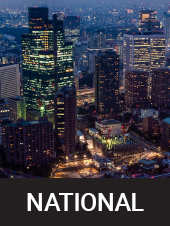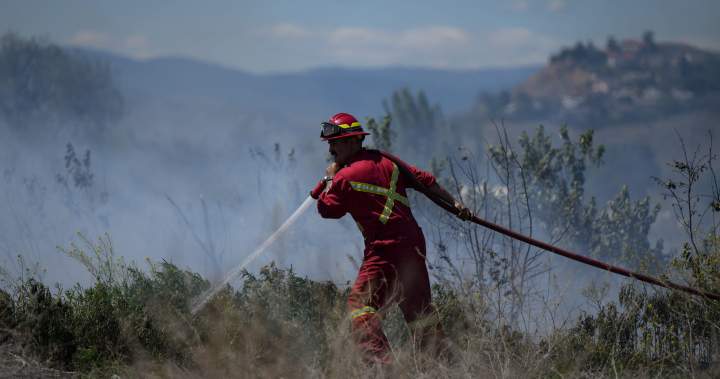As Canada’s wildfire seasons continue to get worse, the country’s firefighting and prevention strategies are being scrutinized both at home and abroad.
One common question has been a simple one: why can’t Canada simply put out all the fires burning across the country?
Forestry scientists and firefighters themselves say there are many reasons why that’s impossible, from environmental considerations to limits on resources to the harsh terrain where some fires are burning.
“People think it’s obviously a simple solution: you put the wet stuff on the hot stuff and that’s the end of it. But it is of course a bit more complex than that,” said Sarah Budd, a fire information officer with the BC Wildfire Service.
Some of the calls for action are coming from lawmakers in the United States, where smoke from the fires has been sparking air quality concerns just as they have across Canada for much of the summer.
The federal government earlier this month announced tens of millions of dollars in funding for research projects aimed at improving wildfire prevention strategies, including community and forest management, as fire and climate patterns evolve.
“We’re increasingly looking at (wildfire strategies) more through a lens of resilience, to accepting that there is more fire on the landscape due to changing climate and adapting communities to that reality,” said Steve Taylor, a wildfire scientist at the Pacific Forestry Centre.
“There’s a lot to do” in that regard, he said.
Wildfire strategies depend on the size, intensity and location of a fire, according to the BC Wildfire Service — and not every fire requires the same response.
Budd said firefighters prioritize responding to wildfires that threaten people or infrastructure. That also includes protecting Indigenous communities and historically significant areas, such as culturally-marked trees or archaeological sites.
Many of those blazes would see firefighters respond directly with ground tools like hoses and other gear to try and put out the fire — so long as it’s safe to do so.

Get breaking National news
For news impacting Canada and around the world, sign up for breaking news alerts delivered directly to you when they happen.
For more intense fires, which in B.C. are ranked on a one-to-six scale, “it’s really not safe for us to be sending individual people in there,” Budd said.
Fires ranked four and above may require a planned ignition of additional fuels outside the fire’s perimeter in order to prevent it from spreading.
Both Budd and Taylor noted wildfires are a natural part of a forest’s natural life cycle, particularly in the vast remote regions of Canada.
“Lots of our tree species, particularly in boreal forests …. they’re adapted to survive or reproduce following fire, and so it’s sort of an agent of mortality and renewal,” Taylor said.
“From an ecological point of view, but also from a longer-term fire management point of view, there’s arguments for leaving well enough alone — of letting fires happen naturally.”
Taylor said about 40 per cent of forests in Canada will see wildfires that don’t need to be suppressed to allow for that natural regeneration. Those areas are too remote and difficult to access for firefighters to respond to anyways, he added.
“Under high hazard conditions, if you don’t get there quickly, you’re not going to be effective,” he said, adding fires in remote areas may not be detected until it’s picked up by satellites.
Some politicians and members of the public have also called for the procurement and deployment of more water bombers to douse the wildfires.
Yet Budd says dumping water from air tankers, helicopters and other aerial equipment, while necessary, is not a definitive solution.
“That is not what’s going to put the fire out,” she said. “That’s going to dampen the fire activity, make it a little bit cooler so that our staff can get close enough to it to do some direct action.”
What actually puts a fire out, Budd explained, is extinguishing the fuel and smouldering embers within the ground itself that could otherwise spark up again and restart the flames. That requires on-the-ground technique known as cold trailing, she said.
Budd added high levels of smoke can also make it unsafe for water bombers to fly.
Provincial wildfire authorities often borrow equipment from each other when necessary, including water bombers. Canadian military aircraft and U.S. agencies can also provide resources when necessary.
A spokesperson for National Resources Canada said wildfire risk is increasing due to multiple factors, including climate change, the expansion of people and property into forested areas, and historical management practices.
“Challenges persist in maintaining the occurrence of these natural events, while minimizing the risks wildland fires pose to people, communities, the environment and critical infrastructure,” the statement said.
With wildfires in Canada growing in number and intensity, along with resulting smoke and air quality impacts, Taylor said more research is needed to update wildfire strategies.
He pointed to research in Alaska that’s aiming to limit wildfires in areas of peatland, which can smoulder for a longer period of time and release more carbon and mercury into the atmosphere than fires in other environments.
Yet Taylor said geography will always pose a challenge to extinguishing every wildfire that breaks out, and the focus instead should be on community resilience and prevention.
“We’d look at fuel management, at manipulating through thinning, prescribed burning, harvesting, about manipulating the fuels, the vegetation, to reduce the flammability in areas,” he said.
“There’s probably more that can be done around a whole-of-society approach, particularly when it comes to … planning and zoning and development and building standards. Evacuation planning. There’s a whole host of things to look at.”
Natural Resources Canada said the $45.7 million in research funding announced this month — including $3.9 million for Indigenous-led projects that incorporate Indigenous knowledge and practices — will seek to answer many of those concerns.
Read the full article here


